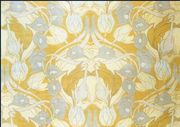Eugène Gaillard
Eugène Gaillard started out by studying jurisprudence but only practised law briefly. Instead he felt drawn to sculpture and later also distinguished himself as a craftsman and furniture designer. Eugène Gaillard became a leading Art nouveau artist of his day, maintaining ties with Siegfried Bing, who marketed Eugène Gaillard's designs for interiors, furnishings and textiles at his gallery, Maison de l'Art Nouveau. The celebrated German art dealer in Paris had a pavilion of his own, "Art Nouveau Bing", at the 1900 Paris Exposition, in which six model rooms simulated living environments. Faithful to the Art nouveau tenet of architecture and interior decoration as a total work of art, Siegfried Bing invented the principle of "creating an ambience" at his exhibitions. Each object shown was to be presented in place in a context replicating the purpose for which it was intended; the natural and organic environment of all things in their proper place was to be clearly demonstrated. All objects shown at that exhibition, including furnishings and textiles as well as objets de vertu, were designed by three artists: Edward Colonna, Georges de Feure and Eugène Gaillard. Until 1914 Eugène Gaillard continued to design furniture in the Art nouveau style;

his pieces were notably elegant and indeed exquisite. Although his forms and motifs were definitely floral in inspiration, they did not represent imitations of nature. Eugène Gaillard explained his approach to furniture design in the 1906 essay "À Propos du Mobilier". In 1901 Eugène Gaillard was a co-founder of the Société des Artistes Décorateurs, at whose Salon exhibitions he also showed his work French designer and architect. Gaillard rejected a career in law to take up interior design and decoration. Siegfried Bing employed him alongside Georges de Feure and Edouard Colonna to create interiors for his pavilion at the 1900 Paris Universal Exposition. The abstract natural forms of his furniture reflected a mistrust of historicism and he became a vocal advocate of modern design. Around 1903 he left Bing's atelier and set up his own firm. In 1906 he published A Propos du Mobilier (On Furniture). eugene gaillard had a strange trip to textile design as he started life by training to become a lawyer. He practised law for only a short time before being drawn into the world of interior design and interior furnishings. Gaillard got his big break when Siegfried Bing started to market his designs for furniture, interiors and textiles at his gallery shop 'L'Art Nouveau'. In 1900 Bing featured Gaillard, along with other leading designers, at his 'Pavillon de l'Art Nouveau' at the Paris Exposition Universelle. Bing's pavilion was arranged as a series of room settings with textiles playing a prominent part in the sets. Gaillards textile designs are typical of most French designs of the period. There is an emphasis on mirror repeats and a muted tonal aspect to the colour schemes. These are very different from the striking graphic qualities of British textile design of the same period. Gaillard was not a serious textile designer, his interests lay in furniture design in particular. He saw his textiles as being part of an ambiance, usually created by Siegfried Bing, and the designs he produced reflect that. However, they are well conceived and well constructed fabric designs and blended well with the Art Nouveau interiors that were being produced at the time.
